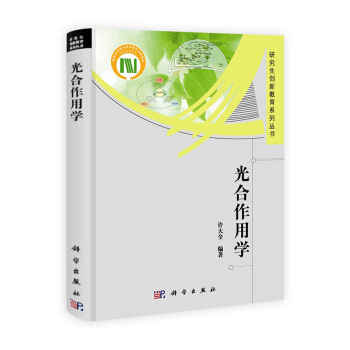![粒子物理概念(第3版) [The Ideas of Particle Physics:An Introduction for Scientists Third edition]](https://pic.windowsfront.com/10914282/4cd9d24a-6c7b-4c93-806f-e006d43d5fca.jpg)

齣版社: 世界圖書齣版公司
ISBN:9787510035104
版次:3
商品編碼:10914282
包裝:平裝
外文名稱:The Ideas of Particle Physics:An Introduction for Scientists Third edition
開本:16開
齣版時間:2011-06-01
用紙:膠版紙
頁數:25
具體描述
內容簡介
The last thirty years have seen an enormous advance in our understanding of the microscopic world. We now have a convincing picture of the fundamental struc-ture of observable matter in terms of certain point-like elementary particles. We also have a comprehensive theory describing the behaviour of and the forces between these elementary particles, which we believe provides a complete and correct description of nearly all non-gravitational physics.Matter, so it seems, consists of just two types of elementary particles: quarks and leptons. These are the fundamental building blocks of the material world, out of which we ourselves are made. The theory describ-ing the microscopic behaviour of these particles has,over the past decade or so, become known as the 'Standard Model', providing as it does an accurate account of the force of electromagnetism, the weak nuclear force (responsible for radioactive decay), and the strong nuclear force (which holds atomic nuclei together). The Standard Model has been remarkably successful; upuntil a year or two ago all experimental tests have verified the detailed predictions of the theory.
The Standard Model is based on the principle of 'gauge symmetry', which asserts that the properties and interactions of elementary particles are governed by certain fundamental symmetries related to familiar conservation laws.
內頁插圖
目錄
PrefacePart 1 Introduction
1 Matter and light
2 Special relativity
3 Quantum mechanics
4 Relativistic quantum theory
Part 2 Basic particle physics
5 The fundamental forces
6 Symmetry in the microworld
7 Mesons
8 Strange particles
Part 3 Strong interaction physics
9 Resonance particles
10 SU(3) and quarks
Part 4 Weak interaction physics I
11 The violation of parity
12 Fermi's theory of the weak interactions
13 Two neutrinos
14 Neutral kaons and CP violation
Part 5 Weak interaction physics II
15 The current-current theory of the weak interactions
16 An example leptonic process:electron-neutrino scattering
17 The weak interactions of hadrons
18 The W boson
Part 6 Gauge theory of the weak interactions
19 Motivation for the theory
20 Gauge theory
21 Spontaneous symmetry breaking
22 The Glashow-Weinberg-Salam model
23 Consequences of the model
24 The hunt for the W, Z0 bosons
Part 7 Deep inelastic scattering
25 Deep inelastic processes
26 Electron-nucleon scattering
27 The deep inelastic microscope
28 Neutrino-nucleon scattering
29 The quark model of the structure functions
Part 8 Quantum chromodynamics-the theory of quarks
30 Coloured quarks
31 Colour gauge theory
32 Asymptotic freedom
33 Quark confinement
Part 9 Electron-positron collisions
34 Probing the vacuum
35 Quarks and charm
36 Another generation
Part 10 The Standard Model and beyond
37 The Standard Model of particle physics
38 Precision tests of the Standard Model
39 Flavour mixing and CP violation revisited
40 The hunt for the Higgs boson
41 Neutrino masses and mixing
42 Is there physics beyond the Standard Model?
43 Grand unification
44 Supersymmetry
45 Particle physics and cosmology
46 Superstrings
Appendices
1 Units and constants
2 Glossary
3 List of symbols
4 Bibliography
5 Elementary particle data
Name index
Subject index
精彩書摘
In order to understand the weak interaction in greater depth, we need to first delve further into the properties of relativistic fermions. In Section 4.2,we Jeamt that relativistic fermions are described by two-component spinors (with another two-component spinor for the antiparticle). In the Newtonian limit,when fermions move slowly, these two components can be interpreted as the two spin states of the fermion: the fermion can either be spin-up or spin-down. However,when the fermions are moving close to the speed of light, the notion of spin is no longer so useful and we need a new way in which to classify the two fermion states. In turns out that there are two useful ways to do this. The first, which is closely related to spin, is to define the helicity as the component of the fermion's spin in the direction of motion of the fermion. The spin can either be aligned with or against the momentum, and the fermion is referred to as being in the helicity-plus or helicity-minus state respectively.……
前言/序言
用戶評價
評分
正品正品正品正品正品正品正品正品正品
評分還不錯,印刷清晰
評分世圖的影印書始終就是裝幀質量一般,還好這本印刷和紙張還行,內容就不評瞭~
評分正在準備閱讀,期待內容不錯
評分概念的東西還是需要原版的理解,中文翻譯後有些錶達不很貼切
評分正在準備閱讀,期待內容不錯
評分。。。。。。。。。。。。。
評分。。。。。。。。。。。。。
評分正在準備閱讀,期待內容不錯
相關圖書
本站所有內容均為互聯網搜尋引擎提供的公開搜索信息,本站不存儲任何數據與內容,任何內容與數據均與本站無關,如有需要請聯繫相關搜索引擎包括但不限於百度,google,bing,sogou 等
© 2025 windowsfront.com All Rights Reserved. 靜流書站 版權所有







![生物化學與分子生物學 [Biochemistry and Molecular Biology] pdf epub mobi 電子書 下載](https://pic.windowsfront.com/11426306/5398fdf2N048684a9.jpg)







![逼近理論和方法 [Approximation Theory and Methods] pdf epub mobi 電子書 下載](https://pic.windowsfront.com/11683614/55419cefN514cc635.jpg)
![走進教育數學:數學解題策略(第二版) [Go-to Educational Mathematicr] pdf epub mobi 電子書 下載](https://pic.windowsfront.com/11720145/55a39647Nb208851e.jpg)



![連續和離散動力係統引論(第2版 影印版) [An Introduction to Dynamical Systems:Continuous and Discrete] pdf epub mobi 電子書 下載](https://pic.windowsfront.com/12166168/590fe764N1c47ee64.jpg)